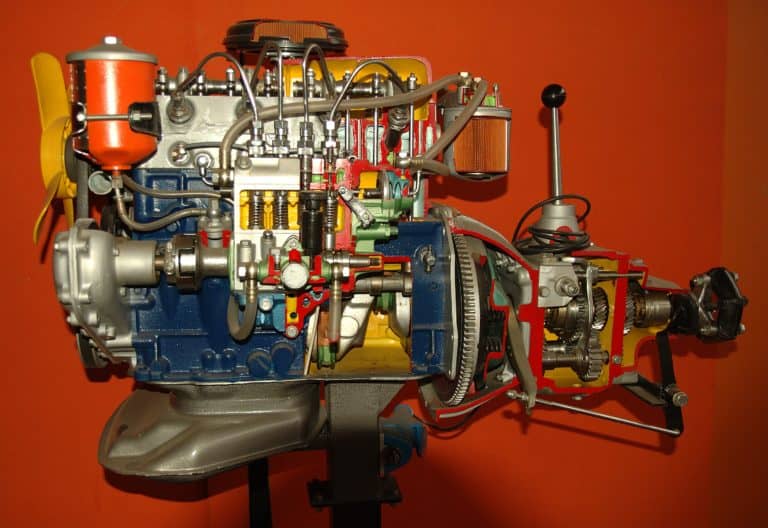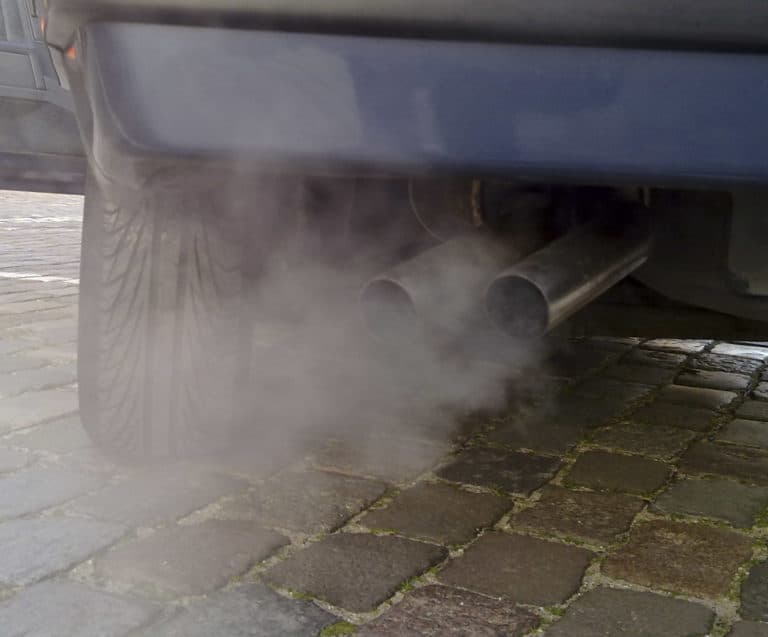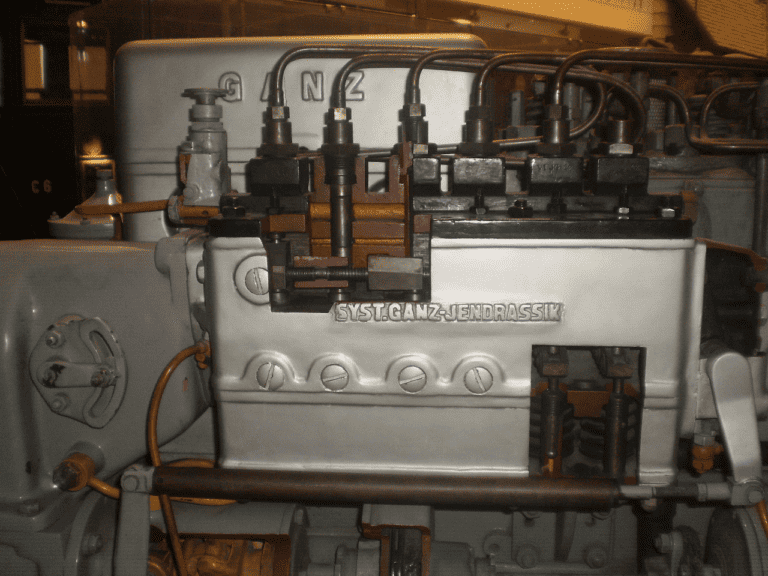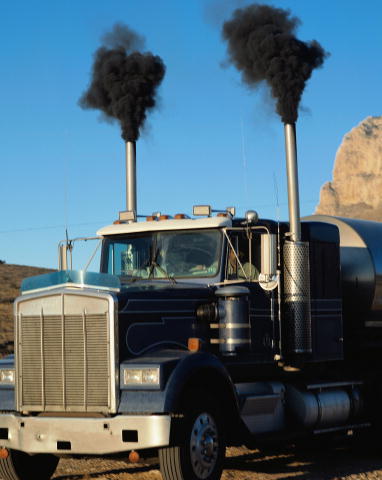
Blue Smoke and Compression Ratios
Blue smoke is usually a sign that the engine is burning oil; but why would a diesel burn oil? Well, the short answer is that diesels get very hot, and they stay hot for longer than gasoline-powered engines because of the way they work. Gasoline engines operate in a much ‘safer’ range for the oil, so when something goes wrong with a diesel, it’s much more likely to burn the oil. But why’s the diesel hot, and what’s going wrong?
Diesels use ‘compression ignition’, where the compression of the air increases the temperature enough to begin the combustion. This is very different from a gasoline-powered engine, which uses ‘spark ignition’, where an electrical arc initiates an explosion. What about glow plugs? Well, not all diesels have them, and in those that do, glow plugs are (only) there to help with starting.
Compressing any gas increases its temperature, in proportion to the pressure increase; letting the compressed gas expand will cause it to cool. This effect is why air compressors get hot, and why pressurized air and carbon dioxide always feel cold when you let them expand. In the case of a an engine cycle, this compression is known as adiabatic compression, which just means compression in an isolated environment (the cylinder).
So diesels create an environment likely to burn oil, by getting really hot, and staying that way, but what’s making the oil burn? Well, there are a few likely causes:
- There is a bad seal between the piston and the cylinder (due to worn or damaged piston rings), making the oil film on the cylinder walls ‘too thick’. This ‘too thick’ film is no longer well-cooled by the cylinder walls (because oil is not a good conductor of heat), so the thickest parts will start to burn.
- The engine is overheating for some reason. A lack of coolant flow, usually due to a pump or coolant passage problem will cause one or more cylinder walls to get very hot, thus overheating the oil, and burning it.
- A very ‘lean’ fuel-air mix can burn too hot, and burn the oil, but this is very rare. Causes of lean mixtures include clogged fuel injectors, or using an under-loaded engine at high RPM.

White Smoke
White smoke is a sign of a ‘rich mixture‘ or water in the fuel. Gasoline engines can produce white smoke just like diesels, but they do so much less often. Wait, what’s wrong with diesels?
Vapor Pressures and Water-Contaminated Fuel
You may have noticed that gasoline tanks are usually sealed (with a pressure release valve), but diesel fuel tanks are usually vented. Gasoline tanks are sealed to prevent contaminants from getting in, so why don’t they do the same for diesels?
The answer is that when you suck the gasoline out of a sealed tank, some of the remaining fuel vaporizes, and keeps the container’s pressure close to atmospheric pressure. If you suck diesel out of a tank, the fuel doesn’t vaporize (much), so you create a vacuum, and either the pump fails, or the tank implodes. Gasoline has a much higher vapor pressure than diesel, which means that it produces a cloud of vapor when exposed to low pressure (in a sealed fuel tank that is being emptied).
The vent on the diesel tank may be necessary for safety reasons, but it also lets air go in and out. The air flowing in and out of the fuel tank carries humidity (water), which can condense in the tank and contaminate the fuel. This water-contaminated fuel then produces steam when heated in the engine, that results in a white cloud (of steam) coming out the exhaust pipe.
From this, we can see that diesels are more likely to suffer from water contamination than their gasoline counterparts. That said, gasoline engines will produce similar steam if water gets in. The most common way for water to get into a gasoline engine is through the intake; any vehicle with a low-mounted intake can suck in quite a bit of water, and produce an impressive cloud of steam!

Governors and Rich Mixtures
Gasoline (as well as natural gas an propane) engines all use throttles to control their speed and power output. Throttles are straightforward devices, usually butterfly valves, which limit the amount of air going into the cylinders (by way of the intake manifold). This air is then mixed with fuel, at some pre-determined ratio (which may be dynamically adjusted), to create the optimum air-fuel ratio for a sudden explosion (triggered by the spark plug). All of this means that gasoline engines run at a fairly constant air-fuel ratio, but diesels are very different!
Diesels don’t use a throttle to control their speed or power output, though some newer ones use a valve to adjust their fuel-air ratios for emissions controls. This is because the diesel engine needs a lot of air in the cylinder, to create the very high pressure and temperature for a compression-ignition. The Diesel cycle also emphasizes a slow, even combustion, not a quick explosion, so there is no need for a perfectly explosive fuel-air ratio.
Diesels have a governor which controls their speed, (usually) regardless of their power output. Governors are control systems which control engine speed by regulating fuel injections. The governor input is (mechanically or electronically) connected to the engine’s camshaft.The governor output is connected to the fuel injectors or pumps, and regulates the amount of fuel injected per cycle, which is known as ‘metering fuel’.
When you press the diesel engine’s control lever forward, you are setting the governor to a different level, which causes more fuel to be injected during each engine cycle. If the governor setting is increased too quickly, it causes too much fuel to be injected, resulting in a ‘rich mixture’, causing an incomplete combustion which produces white smoke.
This white smoke is made up of tiny particles of partially combusted fuel, and is very similar to the white smoke that a poorly tuned gasoline engine would produce.

Black Smoke (Soot) and Temperature
Black smoke, also known as ‘soot‘ is caused by incomplete, low-temperature combustion. When a diesel engine fails to reach its specified pressure, the temperature will also be correspondingly low. There is some debate about exactly how soot forms, but most experts agree that low temperatures cause a slow and incomplete burn where some of the heavier molecules of the fuel stick together, forming larger, dark particles.
Diesels are more likely to produce soot than gasoline engines because they depend on compression to achieve and sustain their required pressure and temperature. When a diesel has (very) low compression, the fuel-air mixture won’t heat up enough to burn completely resulting in large amounts of black smoke. Gasoline engines operate at much lower pressures, and they don’t depend on it for ignition, so low compression will not result in similarly incomplete combustion.
Diesel fuel contains more ‘heavy’, soot-producing molecules than gasoline does. Diesel is a much denser fuel than gasoline, made up of a wide variety of molecules which are larger and contain more carbon than those found in gasoline. Diesel fuel also has a much higher boiling point than gasoline (370C vs 78C), so it can fail to fully ‘vaporize’. This means that when diesel fuel is burned ‘cold’, it creates thick black smoke, whereas gasoline will usually produce a white cloud.
Lastly, some people enjoy producing large amounts of black smoke, known as ‘rolling coal‘. This is achieved by running a very rich mixture, which has two effects: it cools down the air-fuel mix in the cylinder (because the fuel is colder and denser than the air), and it burns cooler (because rich mixtures always burn cooler than lean ones). The ‘coal rollers’ are basically simulating a failing engine!